The Hrvatski Kinoloski Savez (HKS) is the supreme Croatian cynological organisation
on a national level. It was founded in 1891 due to the social need for professional
and systematic care of the dogs. Nowadays, it consists of 137 members; kennel clubs
(associations) and breed clubs from all parts of Croatia. HKS works as a non-profit,
non-governmental organisation whose main goal is to promote cynology through breeding
purebred dogs, preparation and organisation of international activities with other
cynological organisations in the world, taking care for dog health and for the improvement
of relations between people and dogs, the recognition as well as protection of the
rights of its members.
HKS issues internationally recognised pedigrees and cares about education of canine
judges in accordance with the rules of the FCI.
The Croatian Kennel Club, in accordance with the Law of Hunting and Republic of
Croatia’s Animal Protection Act, is authorised to issue certificates of hunting
usability for hunting dogs or conduction of tests and exams of socialisation that
are essential for keeping certain dog breeds.
There are more than 12,000 puppies registered into the Croatian studbook each year,
of which more than 20 % belong to the Croatian native breeds.
The Croatian Kennel Club is mostly proud of and takes special care of Croatian native
breeds. This is visible through the numerous benefits regarding events and breeding,
as well as their regular presentation at the major international cynological events.
The Croatian Kennel Club and its associations organise more than 500 events per
year. More than 50 of them are international.
International dog shows in Croatia are annually entered by 15,000 to 20,000 dogs.
They are of extreme international character, with exhibitors from more than 30 countries.
HISTORY
Roots of cynology in Croatia
1891 - the beginnings of the organised cynology in Croatia, when General Croatian
Society for the Guard of Hunting and Fishing became member of the Austrian society
for purebred dogs in Vienna
1897 – the Studbook Commission was founded
From 5th to 7th September 1906 - the first dog show was held in Zagreb. On the day
after the show, 8th September, the first trial for earth dogs took place
1st October 1925 - Yugoslav Cynological Association (JKS) was founded and on 25th
February 1929, JKS became a member of FCI
1927 - a cynological organisation “Society of Dog Friends” was founded in Zagreb
which in 1932 issues first cynological magazine in Croatia, titled “Our Dogs”
August 28th, 1948 - the Cynological Association of Croatia was founded in Zagreb
January 09th, 1950 - section for judges and judge trainees was founded
July 1st, 1953 - the magazine “Moj pas” (My dog) started to come out; it has remained
the official publication of the cynological association to the present day
In 1954, with the development of cynological activities as well as the increase
of the number of breeds and dogs, clubs were founded instead of sections for dog
groups. This was the period when modern cynology started
Modern cynology
1980 - the 3rd World Championship for Pointing Dogs was held in Umag
1982 - the Cynologocial Association of Croatia published the first Book of Regulations
for Sporting Cynology Expertise, so breeding reviews for all breeds of sporting
dogs were implemented
1985 – the 8th World Hunting Championship was held in Umag
September 2nd, 1990 - Dipl. ing. Marko Medar was elected as the President of the
Cynological Association of Croatia
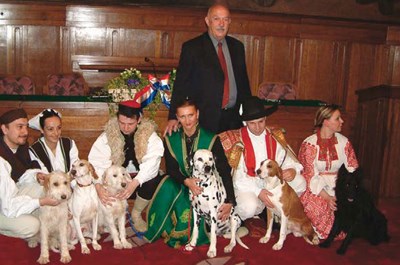

dipl.ing. Marko Medar, President of HKS (1990-2004)
March 1991 - the Cynological Association of Croatia was renamed into the Croatian
Kennel Club
September 1991, the decision was made about the separation from the Yugoslav Cynological
Association
From 28th to 30th September 1991 – first appearance of Croatian national team as
independent country on the 13th World Championship for Pointing Dogs in Alessandria
(Italy). It was for the first time in the history that the Croatian flag was raised
to the winning mast on an international cynological competition. Mr Hari Herak with
his German Shorthaired Pointer Eros di San Foran became our first world champion,
and the Croatian national team were the winners of the team competition for continental
pointing dogs
After the independence
April 1992 - 1st National Dog Show was held in Zagreb. It was entitled “For Croatia”
and the whole income of the show was awarded to the formation for training dogs
in the framework of the Military Police of the Croatian Army
1992 – the Croatian Kennel Club became member of FCI on the General Assembly in
Zurich
June 1992 - the first new Croatian pedigree was issued by the Croatian Kennel Club
September 1995 – for the first time in the European Cup for Hounds, participation
of the Croatian national team. They won the first place in the team competition
March 1996 - the Cup of Nations “For Peace and Friendship” (FITASC) took place in
Umag with more than 500 participants
1999 & 2002 - Croatia hosted again important cynological events: the World Championship
for Pointing Dogs and the Cup St. Hubert were held in Umag (1999) and Zadar (2002)
30th May 1999 - Croatia was awarded with patronage for the standards of Istrian
Shorthaired and Istrian Wirehaired Hound, as well as the Dalmatian. It is an important
date for Croatia because it was then that the FCI Executive Committee, on their
meeting in Mexico City, made the decision that Croatia should be recognised as their
country of origin
2003 - On the European Dog Show in Bratislava, the American Staffordshire Terrier
Milwaukee de Ngorongngorong, owned by Croatian citizen Gordan Bajraktarevic, achieved
a great international success by winning the title BIS
2003 – European Dog Show 2007 organisation was awarded to Croatia by the General
Assembly of the FCI European Section
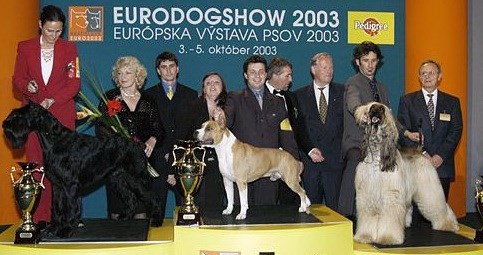

BIS – European dog show 2003 Bratislava
2004 - the longstanding president of the Croatian Kennel Club dipl.ing. Marko Medar
died. In the annals of the Croatian Kennel Club, he will be known - among other
things - for the following achievements in the course of his mandate: the Croatian
Kennel Club became an independent organisation recognised by FCI, several hound
breeds - including the Dalmatian - were recognised as Croatian native breeds
June, 2004 – the new President of the Croatian Kennel Club dr.vet.med. Damir Skok
was elected a member of the General Committee of the FCI European Section
Last 10 years
2005 – the Croatian national team of rescue dogs became world winners on the 2nd
World Championship for Rescue Dogs, held in La Grande Motte (France)


Croatian national team of rescue dogs
October 2005 - Mr Hari Herak with his German Pointer bitch Rina Pradelinensis became
individual world winner on the World Championship for Pointers in Vildbjerg (Denmark)
February 22nd, 2006 - the sixth Croatian native breed Tornjak was recognised provisionally
in the meeting of the FCI General Committee in Madrid under the name “Bosnian- Herzegovinian-and-Croatian
Sheepdog Tornjak” and the breed standard was accepted. The patronage for the standard
is shared by Croatia and Bosnia-Herzegovina
September 2006 - Croatian agility representatives won World championship team title
in Large category in Basel, Switzerland
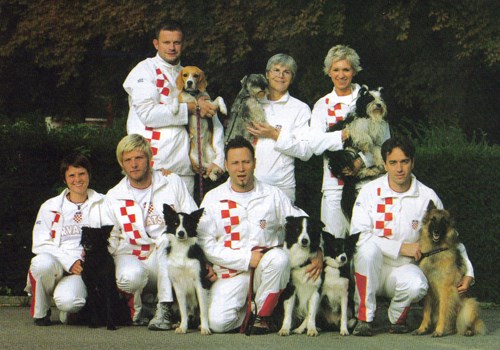

World champions – Croatian national team of Agility dogs
June 8th-10th, 2007 – the Croatian Kennel Club organised the European Dog Show.
The venue of the exhibition was Zagreb. The European dog show was held for the first
time in this region
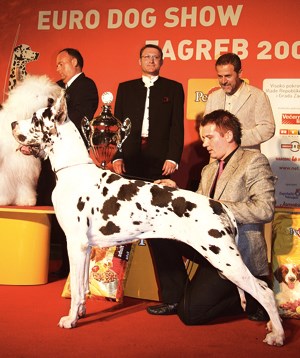

European Dog Show, Zagreb, 8-10/6/2007
2007 - Ana Viller won second place at the World Championship for rescue dogs (work
category in nature) in Austria
2008 - "Croatian Kennel Heritage", book was published by the Croatian Kennel Club,
written by Boris Spoljarić
2008 – repeated success of Ana Viller. She won second place at the World Championship
for rescue dogs (in category searching in nature) in Samobor
2008 - World Championship for Pointing Dogs and Cup St. Hubert were held in Croatia,
near Zadar again. Davor Gmižić won World Cup champion in St. Hubert, and Croatian
national team finished on second place. They were accompanied by the national team
of continental pointers, which won second place. On the Mediterranean Cup, Hari
Herak won first and second places in the competition of continental pointers, which
made the team to win
May 2009 - Main breeding show of native breeds was held for the first time in Varaždin,
which became also the qualification show for election of the HKS representative
who participated on World or European show in this period
2009 – the president of the Croatian Kennel Club Damir Skok was elected as substitute
auditor (FCI accounts) at the FCI General Assembly held in Bratislava
2009 - Croatian kennel club team composed of Gmižić, Herak, Pastorčić won the title
of World Cup champion in St. Hubert and the Croatian national team third place as
a team in the British pointers at the World Championship for pointing dogs and Cup
St. Hubert, held in Greece
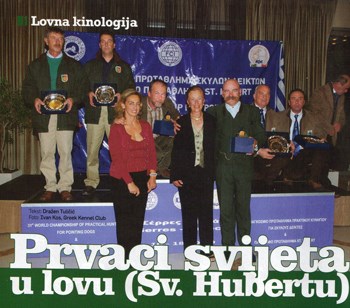

World champions in Cup St. Hubert – Croatian team
2010 - Petra Music had her debut and has become a world Runner-Up at the World Championship
in work for pointing dogs and Cup St. Hubert held in Slovakia in the female part
of the Cup competition Hari Herak became world champion in the individual competition
for continental pointing dogs
2010 - Damir Skok was elected as vice-president of the European section of the FCI
December 30th, 2010 - Little Međimurje dog – Međi was recognised as the seventh
Croatian national breed at the meeting of the Executive Committee
2011 – the Croatian Kennel Club team won the first place at the European Championship
in work of tracking dogs held in Austria, in October
2011 - Croatia won the title of vice world champion in Cup Saint Hubert at the World
Championship in work for pointing dogs and Cup St. Hubert, held in France
October 8th, 2012 – Mr Damir Skok was re-elected as a member of the General Committee
of the European Section of FCI and as a vice-president of European Section at the
General Assembly of the FCI European Section, held in Bucharest
2012 – HKS won first place as a team at the European Championship for tracking dogs
held in October, in Austria
2013 - 12-year-old Ana Pavlović became European Junior champion on European open
championship in Agility which was held in Switzerland


European junior champion in Agility 2013, Ana Pavlović
September 2013 - Croatian junior handling representative Carla Ivančić, on the European
dog show held in Geneva, Switzerland, finished 3rd in the very final
October 2013 - Croatian team won 1st place, while Mr Zdravko Kliček became individual
European champion on the European championship for tracking dogs held in Italy
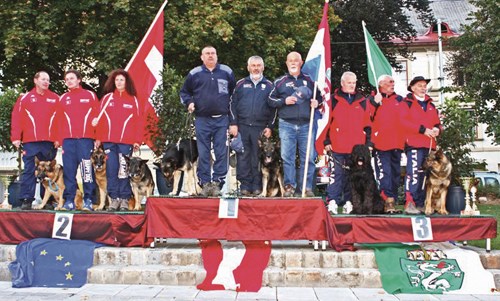

European champions 2013– Croatian national team for tracking dogs
October 25th-27th, 2013 – 35th World championship for working pointing dogs and
Cup St. Hubert were held in Zadar. 26 countries competed, which was the highest
entry number so far
Croatian representative, Mr Davor Gmižić, became World champion in Cup St. Hubert
while we finished second as a team
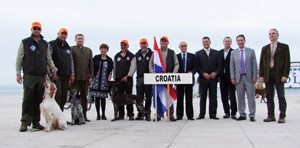

World championship for pointing dogs and Cup St. Hubert – Zadar, 2013
NATIVE BREEDS IN CROATIA
Posavaz hound is named after the Posavina, an area along the Sava River.
As most of our native breeds, it is mentioned in the documents of Diocese of Djakovo
in 14th century. It is considered that it originates from the ancient Pannonian
pointers that Croats found in this region. The oldest records describe Posavaz Hound
as reddish dog with short hair, about 60 cm tall, with white markings on the forehead,
neck, legs and tail, which is used to hunt all sorts of wild animals. It was expanded
throughout whole Croatia. The breed was officially recognised in 1948. Today, it
is described as a medium size dog, lightly built, very active and persistent in
hunting. The head is pronounced, elongated and occipitally rounded. The ears are
flopping while the neck is well muscled and harmoniously connected to the body.
Back is straight, tail is tapering towards the tip. Colour is reddish-wheaten with
the white markings on head, neck, abdomen, lower parts of the legs and the tip of
the tail. It is used in hunting as an extremely diligent hound, because of its great
sense of smell and great resistance. Thanks to its mild nature, it can be a family
dog. It is particularly attentive and suitable for children.


Posavaz Hound
Istrian short and coarse haired hounds were named after the peninsula of
Istria. The breeding of these breeds dates back to 14th century. It is considered
that they have extended to all Croatian regions, although mostly along the coast
of the Adriatic Sea.
The manuscript of Bishop Peter Bakić from 1719 described the hounds 45-60 cm tall,
short or semi-long white hair with reddish spots on their body, bred mostly in Croatian
coastal areas. They are considered the best hunting dogs on the rocky terrain. It
is also interesting that this type of dog has been shown on a miniature missal from
1404.
Istrian Shorthaired Hound today is described as a medium large, well-constructed
dog. The head is elongated, pear shaped with folded ears. The neck is of medium
length, back straight and long. The coat is short, shiny and hard; in general, gives
the appearance of a powerful animal. The characteristic colour of the breed is white
with light brown - orange fields mainly on the head.
Height is standardised by 45-55 cm at the withers. Istrian Short-haired Hound is
a typical hound, works great as individual, but also in the group. It is particularly
functional on hard, rocky and bushy terrain. The breed was officially recognised
in 1949.
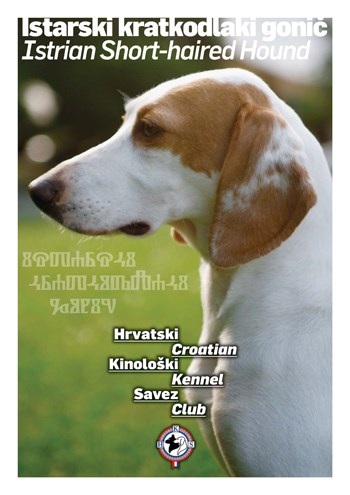

Istrian Short & Coarse Haired Hound
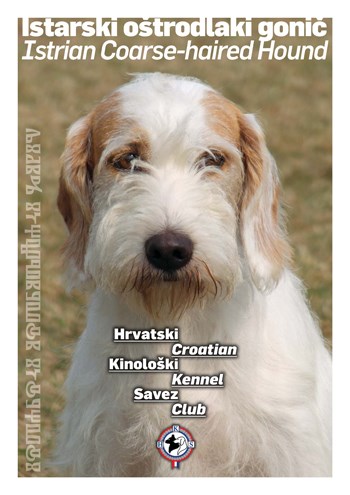

Istrian Short & Coarse Haired Hound
Istrian Coarse-Haired Hound is a harmoniously built and sturdy dog, a bit
robust-looking. It has a harsh hair long 5-10 cm. By constitution is slightly larger
and heavier than the Shorthaired variety, with a strong head that is covered with
harsh moustache on muzzle. Height is from 48-58 cm, and as a breed was officially
recognised in 1948. It is used to catch on rocky terrains as hound dog, as well
as a bloodhound. Its contribution in breeding has a very important role, as the
breed has been used to enrich some other breeds in Italy, Austria and England.
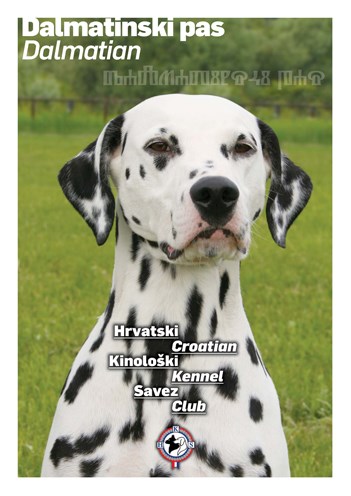

Dalmatian
Some authors believe that Dalmatian originates from ancient Egypt, while
others point out its Mediterranean origins. Named after the province of Dalmatia,
it has been sistematically bred in Diocese of Dakovo as guard dog, carriage and
horsemen companion, as well as military and hunting dog. According to the bishop
Bakic scripts from 1719, breed Canis Dalmaticus has been mainly bred by Croatian
aristrocacy, mostly in Dalmatia, for hunting and personal defense in peace and war.
During the Napoleon wars, Dalmatians spread all over Europe, even to Great Britain.
FCI recognised the Dalmatian in 1955. The breed standard describes him as an intelligent,
temperamental, persistent and loyal dog of harmonious structure with characteristic
short white hair streaked with black or brown spots. Out of all Croatian hounds,
he is the highest with 55 to 60 cm at the withers. In the past it was used for various
purposes like military dog that accompanied the horsemen and caused confusion among
the enemy's horses, as a hunting dog that was fast-running catching prey, as a personal
guard, or even a medieval carriage companion of travelling actor troupes which got
even higher attention thanks to these dogs. Today the Dalmatian is used mainly as
a companion where it shows another of his characteristics; persistent pursuit of
the master. The worldwide popularity of this breed was achieved by W. Disney’s film
“101 Dalmatians".
Croatian Sheepdog probably arrived with Croats from its original homeland.
Breeding of this breed dates back to the era of houses on stilts. Due to its exceptional
pastoral and guard characteristics, its modesty and incredible intelligence, this
breed has been preserved in its original form to this day by expanding through whole
Croatia. The standard was recognised in 1969; the breed is named after the country.
Nowadays, in addition to its genetic predispositions of pastoral and shepherd dog,
because of its agility, skill and speed, it is used in Agility competition where
it achieves outstanding results.
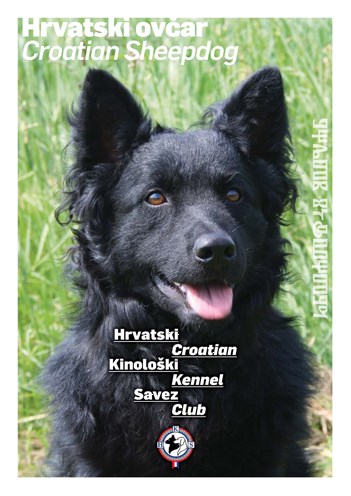

Croatian Sheepdog
Tornjak belongs to a group of big dogs, whose purpose is associated with
the traditional pastoral way of farmers’ life in the high mountains. It is assumed
that it originates - as all similar breeds - in the Himalayas, then dispersing all
over Europe. On an isolated area of the Dalmatian inland and Herzegovina, interbreeding
with native species evolved Tornjak as we know it nowadays. By disappearance of
many herds, this breed was doomed to extinction. In 1982, Zagreb became a basis
for organised breeding, which was made on few dogs left by the former population
in the isolated areas.
Tornjak is a large and powerful dog, with long and firm hair, mainly white-coloured
with dark areas on the head and body. Its height is about 65 to 70 cm, while weighing
more than 50 kg. Although large by size, it is extremely tough, durable and modest.
It seems to be very relaxed and calm, but can become very determined when defending
the trusted flocks. As its name implies, it has always been near its flocks (tor
in Croatian means flock), which it protects from attacks of large predators, mostly
wolves and bears. A systematic programme for the introduction of Tornjak as natural
protection from wolf attacks on the flocks has been conducted in Croatia for a couple
of years. The breed standard was recognised in 2007 and is provisionally recognised
by the FCI.
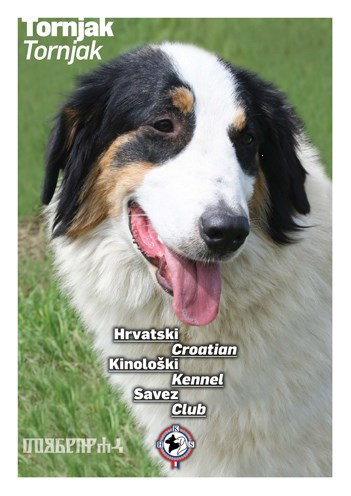

Tornjak
The Small Međimurje Dog is the breed with most recent recognition. The Croatian
Kennel Club officially recognised it as a Croatian native breed in 2010; it is still
a long path towards international recognition.
It has been bred for over a hundred years in the northwest of the country, in Medjimurje.
It is usually seen in rural backyards as a watchdog and hunter of harmful rodents.
Because of these characteristics, the breeding is increasing on modern farms. Because
of its size, it is suitable for breeding in urban environment too. It belongs to
the lupoid type, with erect ears; its height is around 30 cm and its hair is straight,
hard, of short or medium length. There are different colours, the most common combinations
being brown, black, white and grey. It is very devoted to its owner and family.
It is also affectionate and playful in contact with children. It is very intelligent
and impeccably performs verbal commands.
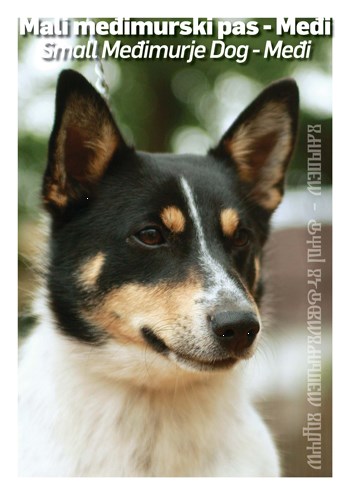

Small Međimurje Dog
Although the Croatian Kennel Club is a relatively small canine organisation, it
is extremely proud of all achievements of its members. The Croatian Kennel Club
will continue to take care of purebred dogs in Croatia, along with improving cynological
culture, morality and ethics and strengthening cooperation with state institutions,
economy and tourism.
The Croatian Kennel club has organised so many great competitions until now! It
is prepared for many wonderful to come.
More information about the Croatian Kennel club can be found at
www.hks.hr
Please feel free to LIKE our page on Facebook:
www.facebook.com/croatiankennelclub